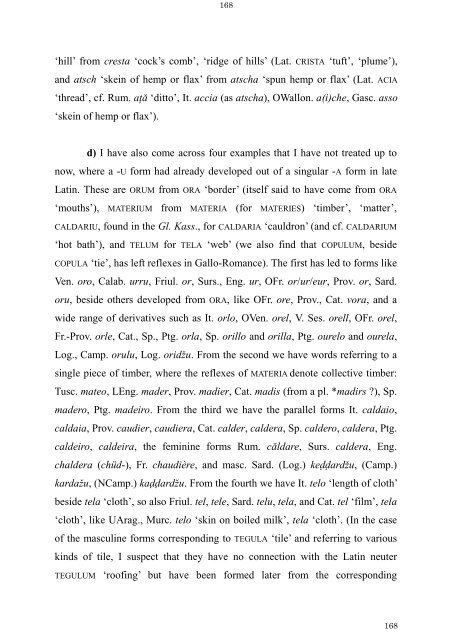The Latin Neuter Plurals in Romance - Page ON
The Latin Neuter Plurals in Romance - Page ON
The Latin Neuter Plurals in Romance - Page ON
Create successful ePaper yourself
Turn your PDF publications into a flip-book with our unique Google optimized e-Paper software.
168<br />
‘hill’ from cresta ‘cock’s comb’, ‘ridge of hills’ (Lat. CRISTA ‘tuft’, ‘plume’),<br />
and atsch ‘ske<strong>in</strong> of hemp or flax’ from atscha ‘spun hemp or flax’ (Lat. ACIA<br />
‘thread’, cf. Rum. aŃă ‘ditto’, It. accia (as atscha), OWallon. a(i)che, Gasc. asso<br />
‘ske<strong>in</strong> of hemp or flax’).<br />
d) I have also come across four examples that I have not treated up to<br />
now, where a -U form had already developed out of a s<strong>in</strong>gular -A form <strong>in</strong> late<br />
<strong>Lat<strong>in</strong></strong>. <strong>The</strong>se are ORUM from ORA ‘border’ (itself said to have come from ORA<br />
‘mouths’), MATERIUM from MATERIA (for MATERIES) ‘timber’, ‘matter’,<br />
CALDARIU, found <strong>in</strong> the Gl. Kass., for CALDARIA ‘cauldron’ (and cf. CALDARIUM<br />
‘hot bath’), and TELUM for TELA ‘web’ (we also f<strong>in</strong>d that COPULUM, beside<br />
COPULA ‘tie’, has left reflexes <strong>in</strong> Gallo-<strong>Romance</strong>). <strong>The</strong> first has led to forms like<br />
Ven. oro, Calab. urru, Friul. or, Surs., Eng. ur, OFr. or/ur/eur, Prov. or, Sard.<br />
oru, beside others developed from ORA, like OFr. ore, Prov., Cat. vora, and a<br />
wide range of derivatives such as It. orlo, OVen. orel, V. Ses. orell, OFr. orel,<br />
Fr.-Prov. orle, Cat., Sp., Ptg. orla, Sp. orillo and orilla, Ptg. ourelo and ourela,<br />
Log., Camp. orulu, Log. oridžu. From the second we have words referr<strong>in</strong>g to a<br />
s<strong>in</strong>gle piece of timber, where the reflexes of MATERIA denote collective timber:<br />
Tusc. mateo, LEng. mader, Prov. madier, Cat. madis (from a pl. *madirs ?), Sp.<br />
madero, Ptg. madeiro. From the third we have the parallel forms It. caldaio,<br />
caldaia, Prov. caudier, caudiera, Cat. calder, caldera, Sp. caldero, caldera, Ptg.<br />
caldeiro, caldeira, the fem<strong>in</strong><strong>in</strong>e forms Rum. căldare, Surs. caldera, Eng.<br />
chaldera (chüd-), Fr. chaudière, and masc. Sard. (Log.) keddardžu, (Camp.)<br />
kardažu, (NCamp.) kaddardžu. From the fourth we have It. telo ‘length of cloth’<br />
beside tela ‘cloth’, so also Friul. tel, tele, Sard. telu, tela, and Cat. tel ‘film’, tela<br />
‘cloth’, like UArag., Murc. telo ‘sk<strong>in</strong> on boiled milk’, tela ‘cloth’. (In the case<br />
of the mascul<strong>in</strong>e forms correspond<strong>in</strong>g to TEGULA ‘tile’ and referr<strong>in</strong>g to various<br />
k<strong>in</strong>ds of tile, I suspect that they have no connection with the <strong>Lat<strong>in</strong></strong> neuter<br />
TEGULUM ‘roof<strong>in</strong>g’ but have been formed later from the correspond<strong>in</strong>g<br />
168









